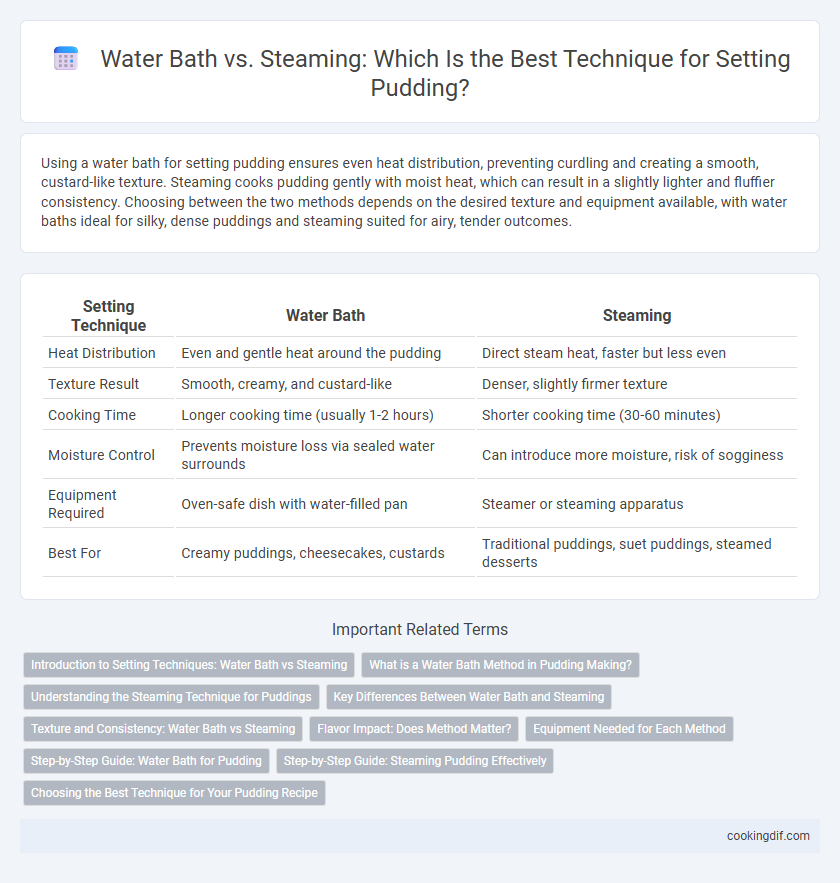Using a water bath for setting pudding ensures even heat distribution, preventing curdling and creating a smooth, custard-like texture. Steaming cooks pudding gently with moist heat, which can result in a slightly lighter and fluffier consistency. Choosing between the two methods depends on the desired texture and equipment available, with water baths ideal for silky, dense puddings and steaming suited for airy, tender outcomes.
Table of Comparison
| Setting Technique | Water Bath | Steaming |
|---|---|---|
| Heat Distribution | Even and gentle heat around the pudding | Direct steam heat, faster but less even |
| Texture Result | Smooth, creamy, and custard-like | Denser, slightly firmer texture |
| Cooking Time | Longer cooking time (usually 1-2 hours) | Shorter cooking time (30-60 minutes) |
| Moisture Control | Prevents moisture loss via sealed water surrounds | Can introduce more moisture, risk of sogginess |
| Equipment Required | Oven-safe dish with water-filled pan | Steamer or steaming apparatus |
| Best For | Creamy puddings, cheesecakes, custards | Traditional puddings, suet puddings, steamed desserts |
Introduction to Setting Techniques: Water Bath vs Steaming
Water bath and steaming are two essential techniques for setting pudding, each offering distinct textures and results. Water baths provide gentle, even heat that prevents curdling, ideal for custard-based puddings like flan or creme brulee. Steaming uses direct moist heat, cooking puddings quickly while maintaining moisture, best suited for traditional steamed suet or rice puddings.
What is a Water Bath Method in Pudding Making?
The water bath method in pudding making involves placing the pudding dish inside a larger pan filled with hot water, which gently and evenly cooks the pudding by surrounding it with moisture. This technique helps prevent the pudding from becoming too dry or developing a cracked surface by maintaining consistent heat and preventing direct exposure to the oven's heat. Unlike steaming, the water bath provides a more controlled environment, ideal for custards and delicate desserts requiring slow, even cooking.
Understanding the Steaming Technique for Puddings
Steaming for puddings involves cooking the batter in a moist, enclosed environment using hot steam, which ensures gentle heat distribution and prevents curdling or cracking. This technique maintains a consistent temperature around 100degC (212degF), preserving the pudding's smooth texture and rich flavor by avoiding direct contact with boiling water. Understanding steaming helps achieve perfect custard-like consistency, making it ideal for delicate puddings such as flan or traditional British suet puddings.
Key Differences Between Water Bath and Steaming
Water bath cooking for pudding provides gentle, even heat by surrounding the dish with hot water, reducing the risk of curdling and creating a smooth, custard-like texture. Steaming involves direct exposure to steam, cooking puddings faster but potentially resulting in a denser texture and less precise temperature control. Key differences lie in heat distribution, cooking time, and final pudding texture, with water bath preferred for delicate custards and steaming suited for firmer, quicker-setting puddings.
Texture and Consistency: Water Bath vs Steaming
Water bath cooking produces pudding with a smooth, creamy texture due to gentle, even heat that prevents curdling, while steaming results in a slightly firmer texture with a more custard-like consistency. The water bath method ensures gradual heat penetration, maintaining moisture and preventing the pudding from drying out. Steaming can lead to a denser pudding, as direct steam heat causes faster coagulation of eggs, impacting overall smoothness.
Flavor Impact: Does Method Matter?
Water bath preserves delicate pudding flavors by providing gentle, even heat that prevents curdling and excessive moisture loss, resulting in a creamy texture with intensified taste. Steaming imparts subtle moisture that can enhance certain aromatic notes but may dilute flavor intensity if not carefully controlled. Choosing between water bath and steaming affects the final pudding flavor profile, with water bath favored for richer, purer taste preservation.
Equipment Needed for Each Method
Setting pudding with a water bath requires a deep baking dish and a shallow pan to hold hot water, ensuring even heat distribution and gentle cooking. Steaming pudding involves a steamer basket or a large pot with a lid to trap steam and cook the pudding evenly without direct contact with water. Both methods demand consistent temperature control, but steaming equipment is generally simpler and more compact.
Step-by-Step Guide: Water Bath for Pudding
Place the pudding mixture into a heatproof dish and cover it tightly with aluminum foil to prevent water from seeping in. Set the dish inside a larger baking pan filled with hot water reaching halfway up the sides of the pudding container. Bake in a preheated oven at 325degF (160degC) for 45-60 minutes, checking periodically until the pudding sets with a slightly jiggly center.
Step-by-Step Guide: Steaming Pudding Effectively
To steam pudding effectively, fill a large pot with water just below the level of the pudding container to ensure even heat distribution without submerging the pudding. Place the pudding mold inside the pot, cover it tightly with a lid or foil to trap steam, and maintain a gentle simmer for the recommended cooking time, usually 45-60 minutes depending on the recipe. This gentle steaming technique prevents the pudding from curdling or drying out, producing a smooth and creamy texture compared to the slower, more uniform heat of a water bath.
Choosing the Best Technique for Your Pudding Recipe
Water bath provides gentle, even heat that prevents pudding from curdling and ensures a smooth, creamy texture, ideal for custard-based recipes. Steaming cooks pudding quickly with moist heat, preserving moisture and creating a lighter, fluffier consistency suitable for sponge-like puddings. Select the technique based on desired texture and cooking time to achieve perfect results every time.
Water bath vs steaming for setting technique Infographic

 cookingdif.com
cookingdif.com